Adventure School participates in the Amazon Services LLC Associates Program, an affiliate advertising program for sites to earn advertising fees by advertising and linking to amazon.com
1. Make a plan
The first step is to plan when and where you want to go camping for the summer. Plan early. Don’t wait until a week out to make plans or you won’t have time to make adequate preparations. You may need to buy specific supplies or book excursions/activities.
2. Pick a destination
Once you know when you’ll go camping, pick a destination. Here’s a resource for finding awesome places to camp near you. camping-usa.com
3. Get reservations
Many public campgrounds – especially the more developed ones – require reservations well in advance if you want a decent shot at staying there. I’ve had success with the walk-in options at some very popular campgrounds, but it’s a gamble if you don’t have a reservation.
You can find campsites near you and book many public campground reservations through reserveamerica.com.
4. Plan your trip activities
Once you know where and when you’ll be camping for the summer, you can plan out your trip details. Camping near a lake with a beach and fishing will be totally different than camping in a wooded forest with a stream. Knowing what you’ll be spending your time doing on the camping trip will dictate how you plan, pack, and set up your camping trip and campsite.

5. Get a map
Once you know what you’ll be spending your time doing while your out camping for the summer, it’s a good idea to pick up a map of the area. I like to have a paper map as well as digital maps with GPX files loaded on my phone and watch for any hikes. Read more about how to prepare for navigating your adventures here.
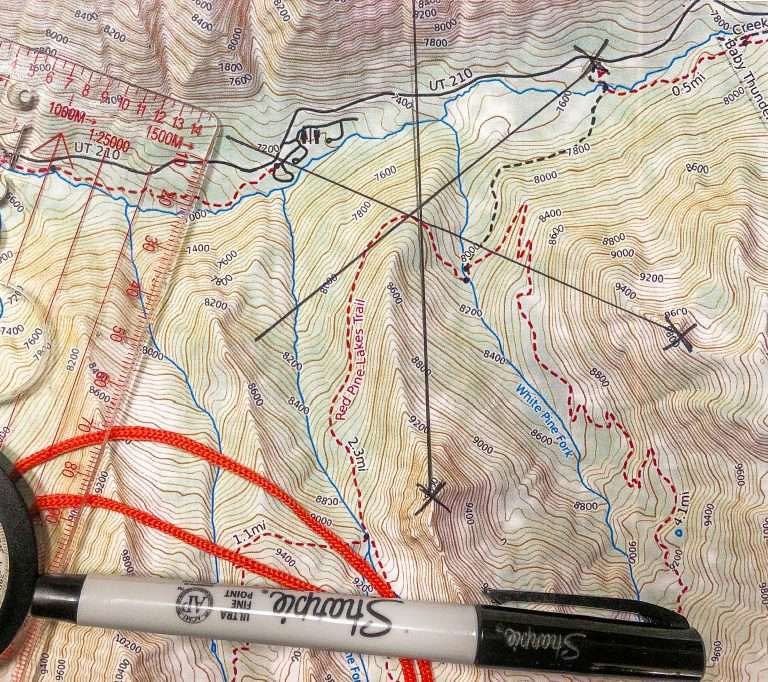
If you’ll be doing anything in the water – and you should because it will be hot – pick up some waterproof paper to print your maps on. I love this stuff and almost always print my maps on it. Even for dry hikes, I can stick a map in my pocket and not worry about it getting ruined from getting sweaty or wet.
-
 Weatherproof Paper$42.65
Weatherproof Paper$42.65
6. Buy the right gear
Once you know where you’re going and what activities you’ll be doing, it’s time to go shopping! As an example, right now I’m planning a summer camping trip to canyon country here in Utah. I’m planning to hike, rock climb, kayak, and canyoneer. I’m going to need to buy the right length of rope for canyoneering, and ensure everyone in the group has the right wetsuits since the water will be cold. I also need to buy a sleeping pad since my 14-year-old is now taller than me and still sleeping on a shortie pad. (Any pad recommendations?)
Learn how to choose the right canyoneering rope here.
I like to do my shopping early so I can find the best deals and have things delivered well in time to organize and pack. Last-minute shopping and packing lead to forgetting things or not being organized and efficient while you’re out.
7. Leave your trip plan with someone
Once you’ve got all your gear (minus the perishable food), and you’ve got a good itinerary set, it’s time to share your plan with others. Leave a copy of your planned itinerary and any secondary or backup plans you may have if the main one doesn’t work. This plan should include your destinations, times planned for each activity and times you plan to return. It can be hard to get exact times but do the best you can. Routes for hikes or other activities you’ll be doing away from camp are especially important as those are the places you’re most likely to get lost or stranded and need someone to come find you.
Many people fail to leave a plan with someone at their own detriment. It’s an easy step to take to ensure you’ll have someone to call in SAR if your trip goes south. I usually leave a plan with my dad because he knows how I plan, he’s an outdoor adventurer too, and he’s got my best interest in mind. He also won’t freak out if I’m a few hours late like my mom would.

8. Use a checklist
I’ve usually got a dozen projects or activities going on all at the same time and checklists are the only way I can stay organized. Always use a checklist for packing for your next summer camping trip if you want to be sure you don’t forget the sunscreen, bug spray, lighter, or chocolate for the smores. I have a base checklist I use for most all activities that I modify for additional adventures or special circumstances. Summer camping can vary greatly from low desert camping where you’ll be in triple-digit temperatures to high-elevation camping where you may be throwing snowballs in July.
To this end, I always customize my checklists and update them as needed. I like to have one checkbox for items I already have and have put in my prep pile and another checkbox for when the item actually goes in the car or bag.
9. Clean your house
In the rush to get out the door, it’s easy to leave dishes in the sink, the floors unswept, and the laundry not put away, but I find nothing more miserable than coming home from an awesome week camping to a messy house. I’m bringing home plenty of stuff to wash, clean, and put away. I definitely want to come home to a clean house so I spend the time up-front to do this and it makes coming home from a long campout that much less work. Especially because when you come home it’s often late at night and you’re exhausted from not sleeping as much as you normally do.

I also like to do a few other things like turn the AC off or down, close all the blinds, lock up the house and find someone to water the plants, feed the pets, and bring in the mail. (BTW … These are all items I like to put on my checklist so I don’t forget them.)
10. Plan your meals
This one’s really a no-brainer. Planning what you’ll eat ahead of a trip goes a long way to being prepared with what you need and enjoying the experience of cooking while camping, but I like to get a bit more intense in my meal planning than just what’s for dinner without getting too rigid. Simple is the name of the game for me when it comes to cooking meals for camping.
Plan meals you like to eat and are nutritionally dense, but that don’t require much equipment or supplies to prepare. I’ll get into this a bit more in a second so keep reading.
11. Make a menu based on activities
When I go camping in summer, I’m almost always doing tons of other things like mountain biking, rock climbing, hiking, kayaking, canyoneering, caving, or other awesome stuff. Often those activities extend over mealtime. If I plan to get up before dawn to hit the trail, I don’t want to plan on pancakes and eggs for breakfast (unless they’re made ahead of time). I’ll opt for something way faster and easier like fruit, yogurt, and some pastries. No mess, no cleanup, and no wait. You can eat it while you hike or on the drive to the trailhead.

The same can go for dinner. If you won’t get back to camp until after dark, don’t plan a meal that will leave you stuck in the kitchen all night doing dishes while you could be relaxing by the campfire. A meal like hamburgers that require little prep, and little cleanup is a great meal while camping. Throw in some watermelon and chips and you’re set.
12. Go shopping
Once you’ve planned out your menu. Go shopping as far in advance of your trip as you can. You don’t want to go so early that your milk will sour or your grapes will go bad, but you also don’t want to have to go shopping on your way out of town if you can avoid it.
Shopping early helps you organize better and allows you to prep as much food in advance as possible, which is my next tip.
13. Prep freezer meals in advance
The more kitchen work you can do before you get out to the campsite, the better. You’ll have more time to relax, adventure, and spend with family and you’ll end up taking less gear which is always a plus in my book.
There are tons of meals you can cook in advance and freeze for easy prep at camp. As a bonus, frozen meals help keep your cooler cold for longer. Here are some meal ideas you can make ahead of time and freeze for easy reheating while camping.
- Sloppy Joe mix
- Hawaiian haystacks
- Curry
- Soup
- Breakfast casserole
- Breakfast sandwiches
- Breakfast burritos
- Enchiladas
- Pancakes/waffles
- Lasagna
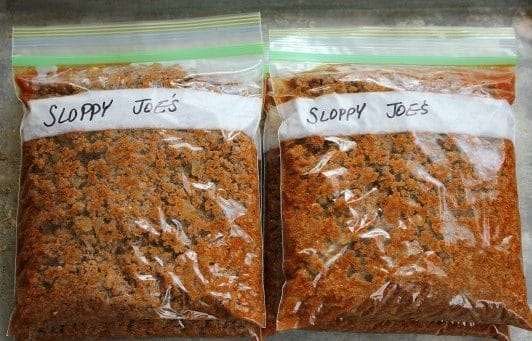
14. Freeze meals in ziplock bags or foil trays
One thing I hate doing at camp is washing dishes. It requires, hauling water, heating water, scrubbing, finding a sanitary place to discard the wash water, waiting for the dishes to dry or hand drying them. By the time you get done with the chore, it’s almost time to do it again.
An easy way to avoid washing dishes while camping is to freeze your pre-cooked meals in ziplock bags. Use the gallon size ones for full meals. When it’s time to eat, all you have to do is heat up a pot of water, put the ziplock in the pot to thaw and heat the food and voila! Dinner is ready and no dishes were made in the process.
If your servings are smaller in size like breakfast sandwiches, use smaller ziplock bags and heat one bag up for each person.
Sometimes freezing a meal in a ziplock doesn’t make sense. Lasagna or enchiladas, for example, wouldn’t fare well in a ziplock. In these cases, you can freeze them in aluminum trays. To reheat, you can put the whole tray in a bag and place the bag in hot water, or you can put the tray on top of a cast-iron skillet over the stove, but this method is more likely to burn the bottom and leave the top cold.
The beauty is, that if your food is already pre-cooked, all you have to do is reheat it, so if one part gets warm enough to serve, you can serve it anytime and don’t have to wait for the whole meal to cook.
Of course, this doesn’t work well if you want to have freshly cooked items or things that don’t freeze well, but I’d much rather play while at camp than cook or clean, so I plan my camping menu accordingly.
15. Have fun cooking
While I hate wasting time cooking while I’m at amazing camping destinations, there are times when cooking can be a great campout activity. Campfire cooking can make cooking at camp fun and unique compared to what you can do at home in the kitchen.
With the right gear or some creativity, you can cook all kinds of things over the open fire. Here are a few ideas:
- chili cheese dogs
- cheese fondue
- hamburgers
- grilled cheese
- corn on the cob
- Tinfoil dinners
- anything you’d cook on a kebab
- skillet nachos

There are a ton of ideas out there on the Google from super simple to gourmet, just search and salivate.
16. Eat well
Speaking of salivating, I may sound a bit spartan in my approach to camping, but I also don’t like to sacrifice taste or variety in my food if I can do it easily, cheaply, and without taking time away from other things I want to do while camping. Plan to eat more while your camping as you’ll be burning plenty of calories hauling water buckets, pounding tent stakes, and swimming in the lake.
I usually bring about 50% more food than I would for eating at home. It’s not as easy to deal with leftovers while camping, but if you follow the ziplock bag method I like to use, you can just stick any extra food back in the same bag and then back in the cooler if you plan to save it.
Also, plan meals you and your fellow campers will enjoy eating. Don’t bring oatmeal for breakfast if nobody likes it.
17. Store food in boxes
-
 Storage Bins$77.50
Storage Bins$77.50
To keep my food organized while summer camping, I love to use plastic totes. They’re stackable, they keep the critters out, and they are easy to organize. I like to organize by day and then inside each box, I may even organize food in grocery bags by meal so I don’t have to rummage through a box to find what I need. I also like to have a box just for snacks so people don’t have to open the other boxes all the time.
Depending on how long you’ll be camping and how many people you’ll be feeding you may only need one box, but having a few lets you organize better.
Once all the food is neatly packed in boxes, I like to keep all the boxes in a cool place out of the sun. Sometimes I’ll bring a small tent to set up underneath a tree for this purpose.
18. Store boxes in a car or bear box if you’re in bear country
If I’m in bear country, I like to keep the food in the trunk or back of the car if there aren’t any bear boxes around. Note that bears can and will try to break into your car to get the food, but I’d rather that than them breaking into the tent where I’m sleeping. You can also hang your food in a tree to keep it away from bears, but if you’re car camping, you often have more food than can practically be hung from a tree.

Here’s a link to more info on camping in bear country
19. Bring plenty of snacks
The snack box is often the most popular place in camp if you load it full of everyone’s favorite goodies. We like to let everyone in the family pick out one or two of their favorite snacks for the campout. When you’re sitting around camp or wetting a fishing hook, a good snack makes everything more fun. Don’t forget the snacks.
20. Bring a pot that doubles as a griddle
-
 Cast iron Skillet$25.99
Cast iron Skillet$25.99
You’ve probably picked up that I’m a fan of minimalism where it makes sense. One way to reduce the kitchen gear you have to bring is with cookware that can be used as both a pot or a griddle. The best tool for this is a large cast-iron skillet. You can cook just about anything in it. For breakfast, whip up a batch of sausage and eggs and then use the same pan (pregreased) to cook the pancakes. At lunch, you can heat up the grilled cheese sandwiches and then heat up the baked beans in the same pan. At dinner time, you can boil the pasta and then heat up the sauce in the same skillet.
The timing may not be ideal, but you can work around that or maybe bring two skillets so you can have both going at the same time when needed. It’s like a swiss army knife for your camp kitchen.

21. Use cast-iron to cook on the fire
To make your experience camping this summer even more memorable, use your campfire for more than just s’mores and smoke. If you bring a cast-iron skillet or pot, especially if it has a lid to keep the ashes out, it’s super easy to cook on a well-built fire. Cast iron pans are thick and better at dispersing the intense heat of a campfire than other types of pans that may not survive campfire cooking. Cast-iron does great in the fire and makes cooking at camp a unique and memorable experience for all.
22. Line with pans foil
If you precook meals and freeze them in Ziplocks, you can avoid many dishes, but sometimes you just want fresh-out-of-the-pan bacon or eggs. To make cleanup easier, it’s simple to line a pan with aluminum foil so when you’re done cooking, you can simply toss it in the trash bag. No dishes! Just don’t toss the foil in the fire pit. it won’t burn away, but will remain in the pit as trash until someone fishes it out.
Also, be careful when lining pans with foil that you don’t rip or tear it with your metal spatula. a wood spatula or spoon is my tool of choice for this situation.
23. Bring big pot for boiling water and dinners
A good-sized stockpot is handy for boiling water to throw your ziplock bagged dinners in or to boil corn on the cob or dishwater or heat water for hot chocolate.
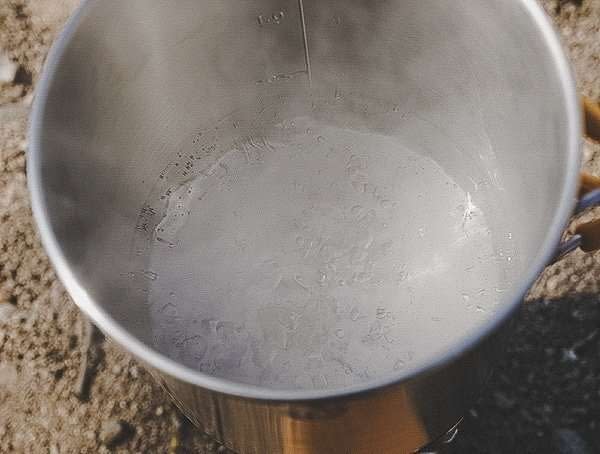
24. Pack smart
Okay, so once you’ve put together all your gear, it’s time to pack it. For some overnight campouts, I’ve simply thrown all my gear in the backseat and was on my way. For other campouts with the entire family where we spent a week or more at camp, there’s no way I could have fit all that gear in and still fit my kids in the car without having to strap them to the roof.
Packing smart means only take what’s necessary, but also pack well. Fill empty spaces. Fill boxes up. Take the cereal bag out of the box or put all the kitchen utensils inside a pot. It’s amazing how you can compress your camping gear down if you pack smart.

25. Pack LIFO
You may be wondering what the heck LIFO means. It’s simply Last In – First Out. Whatever you put in the car first will be the very hardest thing to get out when you show up at your summer campsite. You don’t want to be digging through all the food and water toys just to get your tent out.
If you pack LIFO, you’ll think through the gear you’ll need right when you get to camp. This is usually your tent followed by your sleeping gear and then your kitchen gear. I get very particular about this when I’m backpacking, but for car camping, it’s not as critical. Gear packed in the general order of use will get you close enough that you won’t be throwing your pillow and sleeping bag in the dirt to get your tent out of the car.

26. Pack emergency items strategically
You don’t want to bury your first aid kit or your jumper cables under a huge pile of camping gear. Pack items you may need quick access to around edges that are always accessible – lights, first aid, fire kit, extra water, tools – these are items you should place in spots you can get to without unloading the entire car.

28. Pack by activity
I like to stay organized while I’m at camp so I pack my gear based on each activity. I pack one bag full of my bike gear, another full of my climbing gear, and another with my fishing gear. This way, I don’t have to sift through one main bag or find loose items in my car to go on a ride or a hike. I just grab the bag with the gear for each activity and I’m all set.

Of course, some gear is used for multiple activities, so I usually don’t pack that in an activity bag, but in my main bag. The key is to know where everything is.
29. Label everything
To help me remember where everything is and keep me from rummaging through every bag to find my headlamp, I organize my gear by activity, but also label things. My box of kitchen utensils gets labeled, my snack box gets labeled, and any bag or box with random items gets labeled. If you want to get really organized, you can even put individual items on the label so you know where that headlamp ended up after not seeing it for a few days.
A simple printed page taped on to the box works great. For bags, you can wrap duct tape around the handle with a label written right on the tape.
30. Tarps are awesome
A great tip for your summer camping trip is to bring a few tarps. I like to bring a few different sizes from a smaller 8×8 to a big ol’ 16×32. Tarps are extremely versatile when out camping if you know how to use them. (Let me know if the comments if you’d like to see a post on the many uses of tarps.)
A few ways they can be used are the obvious rain fly over the dining and kitchen areas, but you can also use them to connect the awnings of several tents to create a tent city (made even better if you have a tarp to put on the ground too). You can use a tarp to create a windscreen against the prevailing wind or a privacy wall if your campsite is next to a busy thoroughfare in a public campground. You can use a tarp as a shade canopy during the day to keep you and your coolers out of the hot sun. You can use them to make a changing room or an outdoor shower. You can use them to create an outdoor sleeping area.

You can hang a tarp a few feet above your tent to create more shade while still allowing airflow to keep your tent cooler throughout the day.
I could keep going, but you get the idea. Bring tarps on your next summer campout.
This next set of tips is all about keeping your food cold without the hassle.
31. Freeze food beforehand
I’ve already talked about prepping freezer meals ahead of time to reduce your time spent in the kitchen at camp, but it also greatly helps keep your cooler cold longer if anything that can be frozen is frozen solid before leaving home.
32. Skip the ice bags
Most people will dump a bag of ice in their cooler or maybe you like to use those big blocks of ice that last longer. I’ve done both. I don’t buy bags or blocks of ice for my coolers anymore. They melt and leave all your food sitting in a pool of water. Not only will this water thaw your food faster, but it’s also very unsanitary. Wet egg cartons also don’t work very well. Instead of using ice in bags, use other frozen things.

33. Freeze water bottles
One of the easiest things to freeze is water bottles. They fit well into coolers and are great to have around on a hot summer day at camp. Just pull one out and you’ve got a nice cold drink that also helped to keep your food cold.
34. Freeze jugs
When you need more cooling power than a handful of water bottles can offer, grab a clean milk carton or another jug with a lid and fill it with water and freeze. This is like a block of ice but without the wet melted mess.
35. Put your cooler in water
So this tip is awesome when you have the right conditions, but that’s not typically the case. If you’re camped anywhere near a stream or body of water where it would be safe to do so, you can set your cooler in a secure position in the water and it will stay cool much longer. If nothing else, you can set your watermelon in the stream to cool it off before you eat it.
With this practice, always be mindful of the environment and practice leave no trace principles. That means don’t let anything from the cooler get in the water and don’t leave anything behind.
36. Keep your cooler in the shade
If you can’t keep your cooler in water, the next best place is in a cool, shady spot. This is usually in a stand of trees, but in many places, I camp here in the desert southwest, there are no trees. Under your car or under a picnic table will also work, but be mindful that the shade will move throughout the day as the sun moves across the sky. You’ll need to keep an eye on the cooler and move it as needed.
37. Separate drinks from food
Another simple way to keep your food cold for longer is to put all your drinks in one cooler and your food in another. The drink cooler tends to be opened throughout the day and more often than the food cooler. Drinks aren’t as refreshing when not ice cold, but they aren’t dangerous like food is.
Fill the drink cooler up with frozen water bottles and whatever other beverages you choose and keep the food coolers closed.

38. Pick the best spot for your tent
Wow, this tip could be a blog post by itself! Picking where to pitch your tent is a big deal. Sleep is important when camping and you won’t sleep well if you put your tent in the wrong spot. A few things to avoid are low lying spots if rain is forecast, sunny spots if you want to sleep in at all, noisy or high-traffic spots, or bumpy, or sloped spots.
Look for a quiet spot with trees or rock features on the east side or above it to block out the morning sun if you like to sleep in. Be sure the ground is level and if it’s not quite level, put your heads on the uphill side. Don’t pitch a tent in the middle of a path or too close to the fire or kitchen area.
Sleeping well makes all the difference in a camping trip, so spend the time you need to prep your tent spot. Clear out rocks if you need to, but please don’t damage roots or branches.
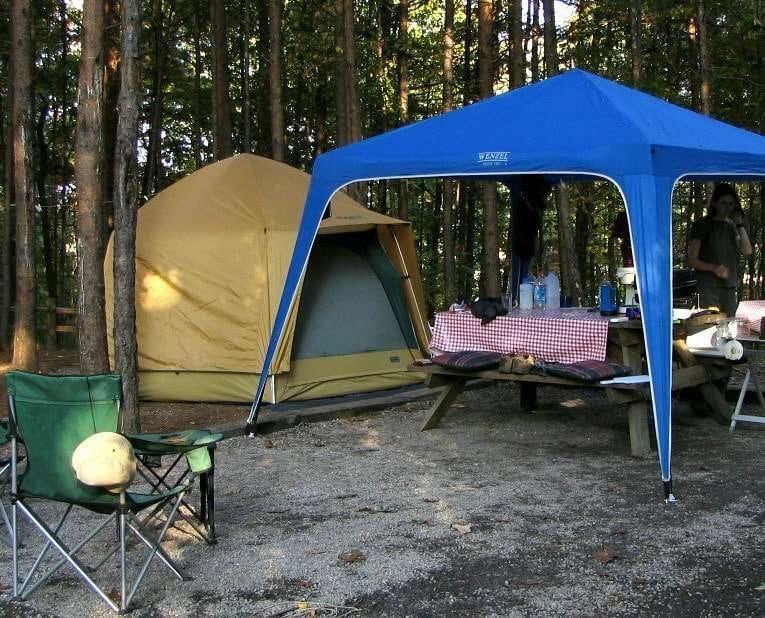
40. Stay out of the sun
Especially during summertime campouts, the sun can wreak havoc on your good times. Sunburn, sunstroke, and heat exhaustion are all real dangers. If you’re not prepared to prevent these problems, they can ruin your campout. The best steps to take are to hydrate, use plenty of sunscreen, cover up using hats, long sleeves, tarps, shade awnings, lip balm with sunscreen in it, sunglasses, and of course, play in the water to stay cool.

Another tip for staying out of the sun while camping in the summer is to pick a campground that has a lot of trees or is near rock formations that provide shade throughout the day.
The next set of camping hacks will help you stay clean at camp
If you’re like my mom, your favorite part of summer camping is the sun. She could sit on her chair on the edge of the lake with a book in one hand and a diet coke in the other all day long, but the one thing she hates about camping is how hard it is to keep things clean.
41. Bring baby wipes
-
Product on sale
 Heavy-Duty Cleaning WipesOriginal price was: $18.52.$14.98Current price is: $14.98.
Heavy-Duty Cleaning WipesOriginal price was: $18.52.$14.98Current price is: $14.98.
Baby wipes are awesome at camp. They can be used in so many situations from wiping off dirty fingers after lunch to wiping down your feet before you climb in the tent at the end of the day.
I typically bring several small packs of wipes and keep packs strategically throughout camp. One in the car, one in the tent, one in the kitchen and another in my day pack- and if you don’t want to smell like a baby, they also make wipes just for camp.
42. Bring an entry mat
Keeping dirt and sand out of the tent goes a long way to sleeping comfortably as well as preventing wasted time each day from cleaning out the tent. An easy way to reduce dirt in your tent is to bring a piece of old carpet or an entry mat to put outside your tent. It’s a great place to leave all your shoes and allows you to go in and out of the tent without having to balance on one foot while you try to get shoes on.
If you have space, having an entry mat inside your tent works to catch any dirt that may try to sneak in.

43. Bring a handheld broom
A small broom can make cleaning up the tent a breeze. You can also pack a full-sized broom if you have space and your tent is large enough to stand up in.
44. Handwash station or sanitizer
To keep your crew from eating with dirty hands, a conveniently placed handwash station near the kitchen is great. Google idea to find the best way to set up a station for your next campout.

45. Bring a pop-up laundry basket
Separating your clean from your dirty clothes while camping can go a long way to helping you have a good time and feel organized. Bring a pop-up laundry basket to put in the corner of the tent or right outside the tent door to keep all those smoky, sweaty, dirty clothes in to keep them from being thrown in a pile in the corner of the tent.
Pop up laundry baskets also work great for small garbage cans. I like to put one between all the tents. They usually aren’t big enough for your main kitchen garbage can, but they do make popup garbage cans that will work for that purpose.
46. Ditch the bug spray
Another way to stay clean and fresh while camping is to ditch the bug spray. I know, you’re thinking I’m crazy right now. Summertime outdoors = tons of bugs. The problem is that bug spray leaves you smelly and oily. No bueno. Use alternate methods to keep the bugs away. Myriad products exist for this purpose, but try a tucking a laundry fabric softener sheet into your pocket to see how it works.
47. Don’t build a fire
Many places you camp in the summertime are plenty warm enough that you don’t need a fire for heat. If you plan to not use it for cooking your meals, you can camp without a campfire. Now, you’re probably thinking “How do you even call it camping if you don’t have a campfire?”
I know campfires are the quintessential symbol of camping, but they’re also completely unnecessary in all but the direst of circumstances and they’re incredibly messy, resource-intensive, and damaging to the environment. They also make you stink while at camp. I won’t get any further on my soapbox here, but know that you can have a great time camping without the campfire (and even do s’mores), and you’ll save yourself from stinking like smoke the whole time.
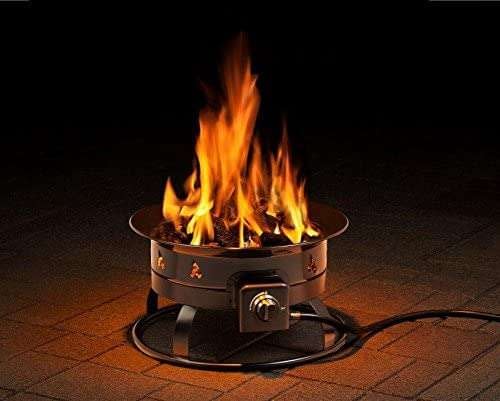
48. Keep your tent windows down
During the day, heat will build up inside your tent if you leave it all zipped up tightly. You don’t want to leave the door wide open because bugs can get inside, but you can leave all the windows down to ventilate the tent so when you go to bed it’s not an oven. This is especially important for canvas tents.
49. Ditch the rain fly
Unless the forecast calls for rain, there’s really no need for a rainfly other than a bit of privacy. If you don’t put the rainfly on, your tent will stay much cooler and you’ll be able to see the stars as an added bonus.

50. Bring a mister
-
Product on sale
 Plastic Spray BottlesOriginal price was: $14.97.$8.96Current price is: $8.96.
Plastic Spray BottlesOriginal price was: $14.97.$8.96Current price is: $8.96.
If you’re camping in a dry place like almost anywhere in the west, bringing a mister along with you can help you stay cool on a hot day. You can also wrap a wet towel around your neck. This is especially refreshing if you use ice water.
51. Pay attention to the wind
If you’re savvy about how you set up your camp in relation to the landscape and the prevailing wind, you can take advantage of the cooling nature of a gentle breeze. Just be warned that if the wind picks up too much, you’ll also be taking advantage of that.
52. Get up early or stay up late
If you’re planning active adventures such as hiking or biking, you’ll be much better off doing it as early or as late as possible. I like to get up before dawn when it’s still dark outside and get going so I can enjoy more of the day while it’s still cool out. An added advantage of this is that animals tend to use the same strategy. You’ll see more wildlife if you’re out at dawn or dusk.

53. Limit electronics
If you’re going out of your way to find an awesome spot to camp this summer with amazing views and plenty of adventure activities, you likely won’t need electronics to keep you entertained. Bring them along as tools to enhance your camping experience, but don’t let them distract you from what you’re doing there. That Netflix movie can wait and you can post all those awesome pics to social media when you get home.

54. Plan for bad weather
You’ve probably heard the saying that if you bring an umbrella it’s sure to not rain. There’s a lot to this statement. I don’t believe our actions can change the weather while we’re camping, but I do know that if you’re prepared for any kind of weather, it won’t be a big deal when that afternoon thunderstorm hits. This starts well before you leave for camp with your packing list, but when you get to camp, you should think through how and where you set up to be ready for a storm or two. Good preparation and forethought will also allow you to not worry if a storm hits while you’re away from camp.

55. Connect with nature
One of my favorite things to do while camping is to get up early – before everyone else – and wander off on my own for a bit. I love to just sit in the still of the morning and observe nature. This meditative state of mindfulness is rejuvenating and engaging. Whatever your favorite place is, find it and enjoy nature while you’re out.
56. Refresh your first aid kit
Each time I go on a big camping trip, I like to take the opportunity to refill anything you’ve used up in your first aid kit. Be sure you have all the supplies you need for your whole group and the length of time you’ll be camping.
57. Avoid poisonous plants
If you want to ruin your summer camping trip in a hurry, go sit in a clump of poison ivy or walk through a stand of poison oak. Poisonous plants can be found throughout the united states so learning to identify the most common ones will help you avoid a miserable summer campout this year. Here’s a link to help you get started.

Here’s a reference if you want to start learning now.
58. Don’t get blisters
Blisters are another campout killer. Avoid them at all costs. Here’s an article I wrote all about how to prevent and treat blisters.
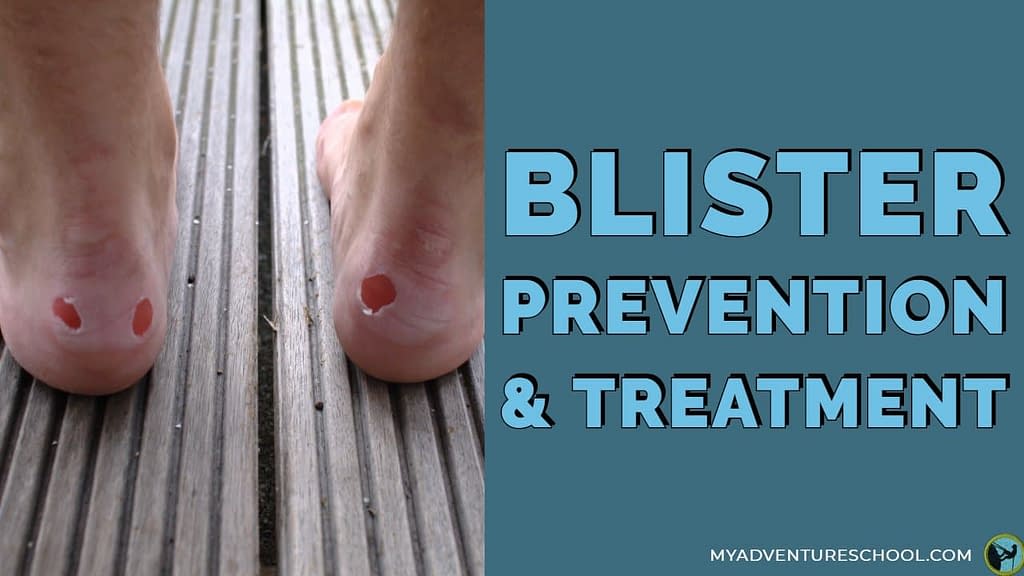
59. Don’t get clotheslined
I’ve seen it too many times. Someone carrying their delicious plate of campfire nachos walks behind the circle of chairs around the campfire to get to their own chair and trips over the tent guy wire losing their entire plate of dinner and dropping their soda in the dirt. They usually scrape up their shin or hand on the tent stake during the fall and it usually happens multiple times in a campout.
The simple solution to this problem is to tie orange plastic tape around the guy wire or to wrap a pool noodle around part of it. Make it visible so people don’t trip.
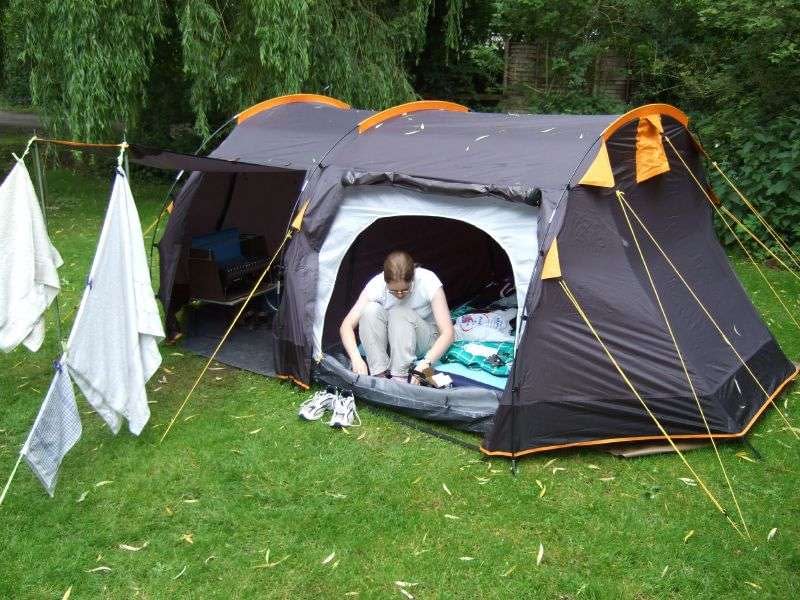
60. Keep ticks off
-
Product on sale
 Permethrin Insect RepellentOriginal price was: $21.90.$17.50Current price is: $17.50.
Permethrin Insect RepellentOriginal price was: $21.90.$17.50Current price is: $17.50.
Ticks are not only nasty bloodsuckers, but they can carry some even nastier diseases. To keep ticks off, you can skip the DEET, and go with permethrin instead. You can buy permethrin laundry additives and wash your clothes in it or you can even buy pre-soaked permethrin clothes.

61. Dress for success
I’m as guilty of this as the next person, but wearing shorts and flip flops around camp is just too appealing for me. The problem is that you run into so many things while camping that can scratch, cut, poke, or smash your bare skin that open-toed shoes or shorts can leave you a bit too exposed. If you want to stay safe, cover up. It will prevent all kinds of injuries.
62. Prep your clothes before bed
Especially if you’re camping at high altitude where the nights can be chilly, a great trick is to pick out your clothes for the next morning before you climb in your sleeping bag. Set them either at the head of your bed or even in the toe of your sleeping bag. This not only saves you time when you’re trying to get up early to enjoy nature, but it also keeps your clothes warm and keeps things quiet for those still asleep.
63. Make night time fun
One of the best times of camping with friends or family is after the sun goes down. Bringing along a guitar if someone has the skill, a good story to tell, or even a deck of cards can make sitting around the campfire an even more memorable experience than it already is.

64. Hang solar yard lights
You can also add some solar lights to your campground to make nighttime navigating a bit easier or hang some strands of lights. You can get some that run on batteries that will add a great ambiance to your campground even in the absence of a campfire.
The next set of tips is about sleeping like a queen or king while your at camp.
Nothing is quite as miserable as laying in your sleeping bag all night, tossing and turning while you try to sleep. Besides playing hard all day to wear yourself out, I’ve listed several tips to help you sleep better at camp this summer.
65. Get a pad that fits your whole tent
-
 Puzzle Exercise Mat$104.99
Puzzle Exercise Mat$104.99
Line your tent with an area rug or a layer of foam tiles to create a padded layer bigger than just the shape of your body with your arms at your sides. The foam tiles are light but easy to assemble to fit the shape of most any tent. If you want a totally custom fit, you can cut them as needed.
66. Use earplugs and a facemask
-
Product on sale
 Sleep Mask with Earplugs SetOriginal price was: $14.99.$9.99Current price is: $9.99.
Sleep Mask with Earplugs SetOriginal price was: $14.99.$9.99Current price is: $9.99.
If you can sleep with them, using earplugs and a facemask can block out unwanted noises as well as keep the morning light out a bit longer if you’re one who likes to sleep in.
67. Bring extra blankets
Even though we’re talking about summer camping here, bringing extra blankets has many benefits. You can lay them under your sleeping bag for extra padding. You can sleep on top of your sleeping bag if it’s too hot, but use a blanket to not be too cold. You can stick an arm or a leg out of your bag, but still have a layer of blankets over it so you’re not too cold.
Extra blankets allow for much more flexibility than just a sleeping bag and if you’re car camping, you should have room for them so throw a few in.
68. Pick a tent and double its size
If you’ve ever bought a tent that said it would sleep four people and then actually tried to fit four people in it, you know the joke that tent sizing is. Sure, it may work for mannequins, but for real living people who actually move and have gear, a four-person tent is better fit for two people.
Buy a tent with plenty of room to organize your gear and stretch out while you sleep and you’ll literally be a happy camper.

69. Ziplocs
I always find that I can use extra Ziploc bags. I bring a variety of sizes. The small ones are great for packing snacks to take on the hike or to the lake while the big ones are great for storing fresh fish to take back from the lake to cook at camp.

70. Duct tape and zip ties
I always find that if something needs fixing or I need to connect things together, duct tape and zip ties are great to have around. I’ve fixed broken tent poles and fishing rods, hung tarps rigged up handwashing stations, and fixed a broken tent zipper with these camp essentials. Don’t leave them at home.
Colored duct tape can also be great for labeling and organizing things.
71. Extra ropes
-
Product on sale
 Colored Duct TapeOriginal price was: $19.99.$14.33Current price is: $14.33.
Colored Duct TapeOriginal price was: $19.99.$14.33Current price is: $14.33. -
Product on sale
 Zip TiesOriginal price was: $10.99.$5.99Current price is: $5.99.
Zip TiesOriginal price was: $10.99.$5.99Current price is: $5.99. -
 Marine Utility Cord$5.00
Marine Utility Cord$5.00
Just like duct tape and zip ties, having ropes of several lengths and diameters is always a good idea to have around to solve problems or rig things up around camp with. Need a clothesline, an extended hammock line, or a perimeter to keep kids out of the kitchen area? A rope will do the trick.
72. Learn a few knots
If you’re going to bring extra ropes, you’ll want to learn a few basic knots to make those ropes work for you. Sure, that quadruple, granny knot may work for a bit, but when the wind blows, down will come your dining fly. These few basic knots can get most things tied up for you:
73. Bring fresh socks
I almost always pack a few extra pairs of socks because there’s little as miserable as coming back from a long hike with wet, dirty and tired feet to not have any extra socks to wear. A fresh pair of soft wool socks to wear around camp after washing your feet makes everything feel better. Of course when it’s really hot out, I usually just stay in my flip flops until bedtime, but then a fresh pair of socks can be great to sleep in too.

74. Stack firewood under a table or nearby tree
Firewood stacked next to the fire pit takes up space in camp, becomes a tripping hazard, and can get wet if it rains. I like to stack firewood next to a nearby tree that’s not too far off, but also not right in camp. This will keep it dry and keep it out of the way. If you don’t have any trees around, you can put it under the end of a table or even under your car.

75. Prepare for the worst and expect the best
A mantra I like to live by is to prepare for the worst-case scenario, but always expect that the best scenario will actually play out. Reality will be somewhere in the middle, but being prepared for whatever circumstance comes up will give you peace of mind and let you sleep soundly at night while the wind blows outside.
76. Leave no trace
When it’s time to finally pack up and head home, be sure you leave your campsite better than you found it. If you dug a trench around your tent, fill it in. If you stacked rocks or logs up around the firepit, to sit on, put them back. Definitely don’t leave any trash including anything that was thrown in the fire that didn’t burn and biodegradable items that aren’t native to your campsite.
Cleaning up after yourself will allow all future campers to have a better, and more natural experience. Don’t take the lazy way out – take the time to leave no trace.

77. Dry out and repack your gear
My least favorite part of camping is putting all my gear away. I do, however, take plenty of time to do it right. I dry everything out thoroughly and pack it away clean and organized so next time I pack up to go camping, I know my gear will be in good shape and ready to use.
If you can get things super clean at camp, you don’t need to unpack and repack when you get home, but usually, there’s dew, dust, or dirt everywhere at camp. At home, you can lay out your gear on the driveway, patio, deck, or even the basement floor to get it extra clean and packed away neatly so it’s ready for next time.
I hope these tips help you when you’re camping for the summer this year. If you’ve got additional tips or ideas, please share them with everyone in the comments.
Also, don’t forget to pick up a handy camping packing checklist to ensure you don’t forget any of your gear.
- 1. Make a plan
- 2. Pick a destination
- 3. Get reservations
- 4. Plan your trip activities
- 5. Get a map
- 6. Buy the right gear
- 7. Leave your trip plan with someone
- 8. Use a checklist
- 9. Clean your house
- 10. Plan your meals
- 11. Make a menu based on activities
- 12. Go shopping
- 13. Prep freezer meals in advance
- 14. Freeze meals in ziplock bags or foil trays
- 15. Have fun cooking
- 16. Eat well
- 17. Store food in boxes
- 18. Store boxes in a car or bear box if you're in bear country
- 19. Bring plenty of snacks
- 20. Bring a pot that doubles as a griddle
- 21. Use cast-iron to cook on the fire
- 22. Line with pans foil
- 23. Bring big pot for boiling water and dinners
- 24. Pack smart
- 25. Pack LIFO
- 26. Pack emergency items strategically
- 28. Pack by activity
- 29. Label everything
- 30. Tarps are awesome
- 31. Freeze food beforehand
- 32. Skip the ice bags
- 33. Freeze water bottles
- 34. Freeze jugs
- 35. Put your cooler in water
- 36. Keep your cooler in the shade
- 37. Separate drinks from food
- 38. Pick the best spot for your tent
- 40. Stay out of the sun
- 41. Bring baby wipes
- 42. Bring an entry mat
- 43. Bring a handheld broom
- 44. Handwash station or sanitizer
- 45. Bring a pop-up laundry basket
- 46. Ditch the bug spray
- 47. Don't build a fire
- 48. Keep your tent windows down
- 49. Ditch the rain fly
- 50. Bring a mister
- 51. Pay attention to the wind
- 52. Get up early or stay up late
- 53. Limit electronics
- 54. Plan for bad weather
- 55. Connect with nature
- 56. Refresh your first aid kit
- 57. Avoid poisonous plants
- 58. Don't get blisters
- 59. Don't get clotheslined
- 60. Keep ticks off
- 61. Dress for success
- 62. Prep your clothes before bed
- 63. Make night time fun
- 64. Hang solar yard lights
- 65. Get a pad that fits your whole tent
- 66. Use earplugs and a facemask
- 67. Bring extra blankets
- 68. Pick a tent and double its size
- 69. Ziplocs
- 70. Duct tape and zip ties
- 71. Extra ropes
- 72. Learn a few knots
- 73. Bring fresh socks
- 74. Stack firewood under a table or nearby tree
- 75. Prepare for the worst and expect the best
- 76. Leave no trace
- 77. Dry out and repack your gear














